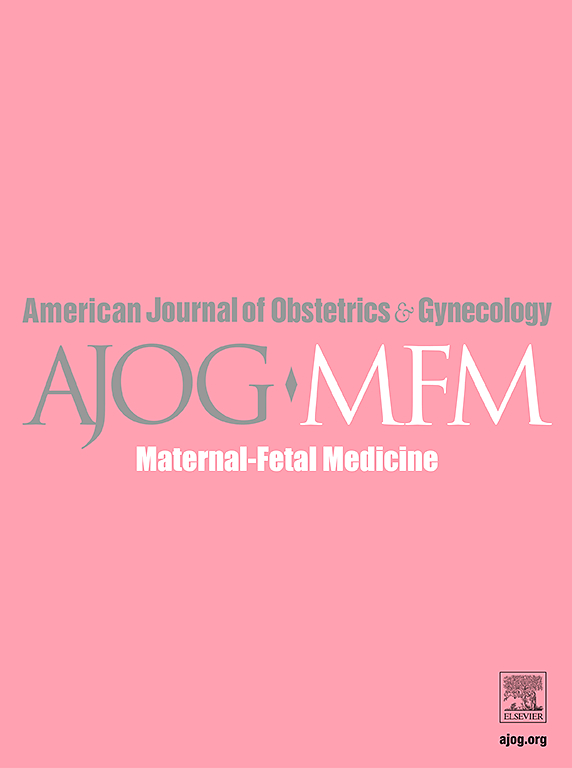Diagnosis of hypertensive disorders in pregnancy
IF 3.1
2区 医学
Q1 OBSTETRICS & GYNECOLOGY
American Journal of Obstetrics & Gynecology Mfm
Pub Date : 2025-05-08
DOI:10.1016/j.ajogmf.2025.101693
引用次数: 0
Abstract
Hypertensive disorders of pregnancy, including chronic hypertension (CHTN), superimposed preeclampsia, gestational hypertension, and preeclampsia, affect 10% to 20% of pregnancies and are a significant cause of maternal and perinatal morbidity and mortality. The incidence of these disorders is increasing because of factors, such as advanced maternal age, obesity, assisted reproductive technology, and increased rates of preexisting comorbidities. Differentiating pregnancy-associated hypertension from preexisting CHTN is challenging, as the overlap between the 2 may be broadening because of the changing demographics of the pregnant population. This review critically evaluated the evidence regarding the current periods recommended to make a diagnosis of a hypertensive disorder of pregnancy. This review does not provide evidence to support the arbitrary 4-hour period or any particular period for the diagnosis of hypertensive disorders in pregnancy. In addition, there is no clear definition of what is considered persistent or sustained blood pressure elevations in blood pressure. Every effort should be made to ensure accurate diagnosis of new-onset elevated blood pressures during pregnancy before labeling the patient with the diagnosis and, thus, recommending serial maternal and fetal testing and delivery at or before 37 weeks of gestation.
妊娠期高血压疾病的诊断:妊娠期高血压疾病。
妊娠期高血压疾病,包括慢性高血压、叠加性子痫前期、妊娠期高血压和子痫前期,影响10-20%的妊娠,是孕产妇和围产期死亡的一个重要原因。由于产妇高龄、肥胖、辅助生殖技术以及先前存在的合并症发生率增加等因素,这些疾病的发病率正在上升。区分妊娠相关高血压与已有慢性高血压具有挑战性,因为由于怀孕人口的人口结构变化,两者之间的重叠可能会扩大。这篇综述批判性地评价了关于当前推荐的妊娠期高血压疾病诊断的证据。我们注意到没有证据支持任意的4小时时间段或任何特定的时间段来诊断妊娠期高血压疾病。此外,对于什么是持续或持续的血压升高并没有明确的定义。应尽一切努力确保准确诊断妊娠期间新发血压升高,然后给患者贴上诊断标签,从而建议在妊娠37周或之前进行一系列母婴检测和分娩。
本文章由计算机程序翻译,如有差异,请以英文原文为准。
求助全文
约1分钟内获得全文
求助全文
来源期刊

American Journal of Obstetrics & Gynecology Mfm
Medicine-Medicine (all)
CiteScore
7.40
自引率
3.20%
发文量
254
审稿时长
40 days
期刊介绍:
The American Journal of Obstetrics and Gynecology (AJOG) is a highly esteemed publication with two companion titles. One of these is the American Journal of Obstetrics and Gynecology Maternal-Fetal Medicine (AJOG MFM), which is dedicated to the latest research in the field of maternal-fetal medicine, specifically concerning high-risk pregnancies. The journal encompasses a wide range of topics, including:
Maternal Complications: It addresses significant studies that have the potential to change clinical practice regarding complications faced by pregnant women.
Fetal Complications: The journal covers prenatal diagnosis, ultrasound, and genetic issues related to the fetus, providing insights into the management and care of fetal health.
Prenatal Care: It discusses the best practices in prenatal care to ensure the health and well-being of both the mother and the unborn child.
Intrapartum Care: It provides guidance on the care provided during the childbirth process, which is critical for the safety of both mother and baby.
Postpartum Issues: The journal also tackles issues that arise after childbirth, focusing on the postpartum period and its implications for maternal health. AJOG MFM serves as a reliable forum for peer-reviewed research, with a preference for randomized trials and meta-analyses. The goal is to equip researchers and clinicians with the most current information and evidence-based strategies to effectively manage high-risk pregnancies and to provide the best possible care for mothers and their unborn children.
 求助内容:
求助内容: 应助结果提醒方式:
应助结果提醒方式:


